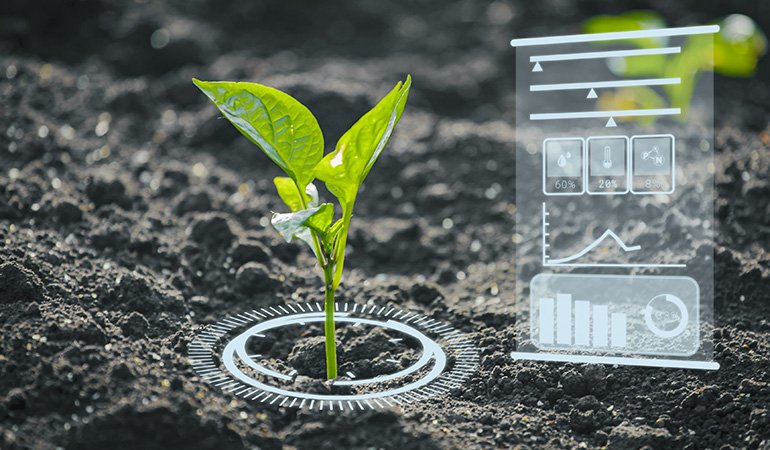Saturday, 22 November 2025


In an exclusive AgroSpectrum interview, Prashant Mishra, Founder and CEO of AgriPilot.ai, reveals how Baramati has become India’s most advanced AI-powered agricultural living lab, driven by spatial analytics, cloud agronomy, and deep field-level data. Mishra explains that the convergence of affordable compute, Microsoft’s Planetary Computer, and high-density IoT networks has finally made precision agronomy commercially scalable for millions of smallholders. He details how AgriPilot.ai’s vernacular, WhatsApp-native, invisible-AI interface is enabling farmers to leapfrog digital complexity and adopt predictive, outcome-based decision-making at unprecedented speed.
With global tech leaders like Elon Musk and Satya Nadella publicly acknowledging India’s rapid agri-AI innovation, Mishra argues that the country is quietly building one of the world’s most sophisticated autonomous agronomy ecosystems. He believes that by 2030, more than half of India’s farmers will be connected to AI-driven irrigation, fertigation, and phenology systems—marking a historic shift from reactive to predictive farming.
The Agritech Inflection Point
Baramati has emerged as one of India’s most advanced AI-driven agricultural living labs. Beyond the headline-grabbing deployments, what is the deeper structural inflection point that has finally made spatial AI, cloud agronomy, and real-time data ingestion commercially scalable in Indian agriculture?
The most significant shift is that digital agriculture has matured to the point where outcomes clearly justify the cost for farmers, institutions, and governments. A decade ago, building an integrated spatial agronomy system—one that fused satellite analytics, field IoT, and cloud-based modelling—was a prohibitively expensive exercise reserved for research institutions. What has transformed the landscape is the convergence of affordable compute, planetary-scale datasets, and more efficient model architectures. Microsoft’s Planetary Computer ecosystem, driven in large part by the pioneering work of Dr. Ranveer Chandra, Managing Director for Research for Industry and the CTO of Agri-Food at Microsofthas given us access to 20 to 50 years of environmental, hydrological, and land-use data.
This allows our models to be trained on a depth and richness of historical patterns that were simply unavailable earlier. Cloud infrastructure has become dramatically more cost-efficient, enabling us to run high-resolution spatial models for entire districts at a fraction of what it cost even five years ago. Affordable IoT sensors, better bandwidth in rural India, and the reliable availability of satellite time-series data have all created a structural inflection point where advanced agronomy models that once required crores to run can now be delivered sustainably at the village level. When technology begins delivering more outcomes at a lesser cost than traditional advisory systems, scale becomes inevitable.
The Farmer–AI Interface
One of the long-standing criticisms of digital agriculture is that tools often overwhelm farmers rather than empower them. How are you designing a farmer interface where AI becomes almost invisible instead of a new layer of complexity?
The first principle is that farmers do not want more apps, menus, dashboards, or layers of information. They want clarity delivered in a manner that matches their daily workflow. In the last three to four years, two things have changed dramatically: rural smartphone penetration has risen steadily, and WhatsApp has become the de facto operating system of communication for Indian farmers. They are already comfortable checking mandi prices, sharing pictures of pests, seeking advice from input dealers, and coordinating labour.
What we’ve done is ensure that AI amplifies this behaviour instead of competing with it. Our system is vernacular-first, voice-led, and advisory-light. The intelligence sits in the background, analysing soil signatures, crop growth stages, irrigation cycles, and stress indicators. What the farmer receives is not a dense advisory but a simple, timely nudge: irrigate tomorrow, reduce urea, spray only half the block, expect a pest shift in seventy-two hours. This transforms AI from an external layer into an invisible decision-support companion. The goal is not to introduce more technology into the farmer’s life but to simplify the decisions they already make every day.
Data as the New Fertiliser
You now capture high-frequency soil, crop, climate, irrigation, and input-use data across thousands of acres. What are the biggest bottlenecks in converting this enormous pipeline into actionable, trustworthy agronomic intelligence, especially during extreme climate events?
Data abundance does not automatically translate into intelligence. The primary bottleneck lies in the unevenness of microdata. Nutrient imbalances, micronutrient deficiencies, and hyper-localised microclimates vary dramatically even within a thirty-acre cluster. In many regions, we are still working with partial datasets because sensors are scattered unevenly and historical baselines—especially for micronutrients—are incomplete. The second challenge is the physics of crop canopies. For example, in paddy, once the crop reaches a certain height and density, satellite imagery loses the ability to read ground conditions accurately, which creates blind spots during critical phenology windows. The third barrier is the reliability of data during extreme weather.
Storm events, cloud cover, and sensor outages during heavy rainfall can distort readings, forcing models to operate with uncertainty. Our approach has been to build fusion models that combine soil sensors, drone-based thermal and multispectral imagery, on-ground scouting notes, micro-weather stations, and long-term climatic curves. Instead of forcing the model to be perfectly accurate, we are teaching it to recognise uncertainty and downgrade confidence scores when the data environment is unstable. The future of agronomic AI is not just precision but resilience—systems that continue to guide farmers even when the environment becomes unpredictable.
Platform Economics and Monetisation
As AI agronomy platforms search for sustainable business models, which revenue architectures seem realistically scalable in India’s unique agricultural environment?
The Indian market rewards affordability and penalises complexity. That is why our monetisation strategy is intentionally straightforward: Rs 2,000 a year for all the acres a farmer holds. If we cannot guarantee a minimum four-to-five-fold return, the business model is not viable. What we are witnessing on the ground is far more encouraging. Sugarcane farmers using our platform have reported incremental gains approaching Rs 1,00,000 per year.
Rice farmers, even with smaller landholdings, are seeing benefits of around Rs 25,000. These numbers are not aspirational—they are real outcomes rooted in reduced input wastage, smarter irrigation timing, and early pest detection. Over time, we see monetisation evolving into an ecosystem model. Insurers, fertiliser companies, agri-lenders, FPOs, and procurement platforms can all plug into the intelligence layer, because accurate data reduces their risks, improves underwriting, streamlines supply chains, and reduces fraudulent claims. The long-term opportunity is not to charge farmers more but to build a data backbone that creates shared value across the entire agri-economy.
Partnership with Big Tech: Beyond the MoU
Microsoft’s involvement is being seen as a statement that hyperscalers are taking agrifood ecosystems more seriously. How has cloud acceleration, spatial computing, and co-innovation changed your product velocity and capabilities?
Collaboration with Microsoft has fundamentally changed both the speed and the ambition of our product roadmap. With cloud acceleration, we can run multi-layered spatial datasets—soil moisture maps, evapotranspiration models, canopy thermal stress patterns, and hydrological flow lines—at district scale without operational bottlenecks. Spatial computing allows us to interrogate these layers simultaneously and generate precise stress predictions for each field.
The partnership also allows us to experiment with autonomous scouting models that automatically identify pest signatures, nutrient deficiencies, and canopy stress from images sent by farmers or captured through drones. The Gates Foundation has played an equally important role by shaping the scientific and data governance frameworks that ensure our models are both rigorous and equitable. This combination of hyperscale compute and scientific stewardship has helped us leapfrog several stages of development and build capabilities that were considered futuristic even five years ago.
Scaling Across India’s Agro-Climate Diversity
India’s 127 agro-climatic zones make it one of the most complex agricultural environments on earth. How do you scale AI across such diversity without compromising precision or farmer trust?
Scaling AI in agriculture is not about software rollouts; it is about biological and geographical adaptation. We expand only where the ground truth is mature, which means beginning every new geography with dense IoT installation—soil sensors, humidity meters, micro-weather stations, seepage trackers, and canopy monitors. The data generated here becomes the reference point against which the model learns the reality of that micro-zone. A model trained in Baramati cannot be copy-pasted to Vidarbha or Anantapur or the Cauvery Delta.
Each climate zone has its own rhythm, nutrient history, pest cycles, cropping intensity, and water availability patterns. By working zone by zone and validating our predictions against field-level conditions, we build trust. Farmers quickly recognise when a system understands their soil type, their local weather quirks, and their crop’s specific vulnerabilities. The role of device manufacturers and hyperscalers like Microsoft will become even more critical as we scale because the integrity of the AI layer depends on the stability of the data layer beneath it.
Vidarbha Oranges: A Strategic High-Value Opportunity
Vidarbha’s Nagpur orange belt is grappling with climate volatility, citrus greening, and market unpredictability. What is AgriPilot.ai’s strategic agenda for citrus, and how do you plan to transform yield stability and quality premiums in this marquee horticulture cluster?
The Nagpur orange is one of India’s most iconic horticulture assets, but it is also among the most vulnerable. Climate volatility has shortened flowering windows, citrus greening has intensified, and micronutrient imbalances have become widespread. Our strategic agenda focuses on rebuilding citrus intelligence from the ground up.
We have signed an MoU with the region’s horticulture university, and standard operating procedures for field trials, nutrient benchmarking, and phenology tracking are already established. Spatial AI will help us detect early stress signatures long before they become visible to the eye. By mapping canopy density, chlorophyll patterns, and soil nutrient flows in real time, we can guide farmers on precise micronutrient dosing and timely interventions that directly influence fruit size, sweetness, colour, and shelf life. We anticipate yield improvements of close to thirty percent in the coming years, but the larger benefit will be quality stability, which is critical for premium pricing in domestic and export markets.
The 2030 Vision: Autonomous Agronomy
Looking ahead to 2030, do you envision Indian farms operating on an autonomous agronomy backbone where irrigation, fertigation, pest intervention, and phenology forecasting run with minimal friction? Which components are already ready, and which require fresh breakthroughs?
Many components of autonomous agronomy are already functional in pilot environments. Irrigation scheduling models that use soil moisture curves and evapotranspiration forecasts are running at near-autonomous levels. Fertigation systems are becoming responsive rather than reactive, adjusting nutrient supply based on real-time canopy stress and soil feedback. Early pest detection through image-based AI is maturing rapidly. Phenology forecasting—predicting flowering, fruit set, and canopy transitions—is entering a phase where it can be reliably deployed in high-value crops.
The next big step is interoperability: building a unified data ecosystem that connects every device, sensor, and model without fragmentation. The EkStep Foundation is playing a pivotal role in building this federated architecture where data from multiple clusters can be accessed, validated, and used to strengthen collective intelligence.
By 2030, we expect between fifty and sixty percent of India’s farmers to be connected to at least one layer of autonomous agronomy. Achieving full-stack automation across all crops will take longer, because it requires breakthroughs in robotics, plant-physiology simulation, next-generation sensing physics, and real-time multimodal AI fusion. But the direction is irreversible. Indian agriculture is moving towards a future where intelligence flows continuously and farming moves from reactive to predictive to autonomous.
— Suchetana Choudhury (suchetana.choudhuri@agrospectrumindia.com)